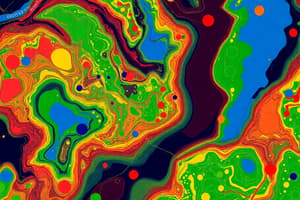Podcast
Questions and Answers
What do contour lines on a map represent?
What do contour lines on a map represent?
- The elevation and shape of the terrain (correct)
- Natural resources like minerals
- Man-made features only
- The locations of water bodies
Which of the following is NOT a feature represented by polygons on a map?
Which of the following is NOT a feature represented by polygons on a map?
- Roads (correct)
- Boundaries
- Urban regions
- Lakes
What characterizes vector data representation in GIS?
What characterizes vector data representation in GIS?
- It represents data as a continuous grid
- It primarily consists of pixelated images
- It uses colors to represent different land types
- It uses points, lines, and polygons for discrete features (correct)
Raster data is particularly well-suited for which type of information?
Raster data is particularly well-suited for which type of information?
Which information would you find represented as lines on a map?
Which information would you find represented as lines on a map?
In the spaghetti model of vector data representation, how are features stored?
In the spaghetti model of vector data representation, how are features stored?
What do points on a map typically indicate?
What do points on a map typically indicate?
Which characteristic distinguishes raster data from vector data?
Which characteristic distinguishes raster data from vector data?
What is the primary function of a database management system (DBMS)?
What is the primary function of a database management system (DBMS)?
Which of the following best describes a key feature of a Relational Database Management System (RDBMS)?
Which of the following best describes a key feature of a Relational Database Management System (RDBMS)?
What do ACID properties in a Relational Database Management System stand for?
What do ACID properties in a Relational Database Management System stand for?
Which of the following examples is NOT an Object-oriented Database Management System (OODBMS)?
Which of the following examples is NOT an Object-oriented Database Management System (OODBMS)?
What is the advantage of an OODBMS over a traditional RDBMS?
What is the advantage of an OODBMS over a traditional RDBMS?
How does an OODBMS treat data when compared to an RDBMS?
How does an OODBMS treat data when compared to an RDBMS?
What is a primary key in the context of a relational database?
What is a primary key in the context of a relational database?
Which characteristic is commonly associated with object-oriented databases?
Which characteristic is commonly associated with object-oriented databases?
What is a feature of raster maps?
What is a feature of raster maps?
Which statement is true regarding contour lines on a topographic map?
Which statement is true regarding contour lines on a topographic map?
Choropleth maps utilize what to represent data?
Choropleth maps utilize what to represent data?
What characteristic distinguishes dot density maps?
What characteristic distinguishes dot density maps?
Which type of map focuses on themes like climate zones or population density?
Which type of map focuses on themes like climate zones or population density?
What is a distinctive feature of heat maps?
What is a distinctive feature of heat maps?
What do vector maps typically represent?
What do vector maps typically represent?
What aspect of a 3D map enhances understanding?
What aspect of a 3D map enhances understanding?
What is a potential drawback of high-resolution raster data?
What is a potential drawback of high-resolution raster data?
Which resolution category is best suited for urban planning or detailed environmental studies?
Which resolution category is best suited for urban planning or detailed environmental studies?
What does the term 'temporal changes' refer to in the context of spatial data representation?
What does the term 'temporal changes' refer to in the context of spatial data representation?
What factor does NOT influence the conceptualization of spatial data?
What factor does NOT influence the conceptualization of spatial data?
What is the significance of pixel resolution in raster data?
What is the significance of pixel resolution in raster data?
Which of the following is NOT an issue affecting the conceptualization of spatial data?
Which of the following is NOT an issue affecting the conceptualization of spatial data?
What is often a consequence of data at the edges of a map?
What is often a consequence of data at the edges of a map?
In which scenario would medium-resolution raster data be most appropriately used?
In which scenario would medium-resolution raster data be most appropriately used?
Flashcards
Raster Maps
Raster Maps
Maps created using grids of pixels, suitable for representing continuous data like satellite imagery or elevation models.
Vector Maps
Vector Maps
Maps composed of points, lines, and polygons to represent features like cities, roads, and boundaries.
Topographic Maps
Topographic Maps
Maps that highlight terrain features, using contour lines and elevation data.
Contour Lines
Contour Lines
Signup and view all the flashcards
Index Contour
Index Contour
Signup and view all the flashcards
Thematic Maps
Thematic Maps
Signup and view all the flashcards
Heat Maps
Heat Maps
Signup and view all the flashcards
Choropleth Maps
Choropleth Maps
Signup and view all the flashcards
Map
Map
Signup and view all the flashcards
Natural Feature
Natural Feature
Signup and view all the flashcards
Man-Made Feature
Man-Made Feature
Signup and view all the flashcards
Scale
Scale
Signup and view all the flashcards
Map Symbols
Map Symbols
Signup and view all the flashcards
Vector Data Model
Vector Data Model
Signup and view all the flashcards
Raster Data Model
Raster Data Model
Signup and view all the flashcards
Raster Resolution
Raster Resolution
Signup and view all the flashcards
Raster File Size
Raster File Size
Signup and view all the flashcards
Raster Data Redundancy
Raster Data Redundancy
Signup and view all the flashcards
GIS Simplification
GIS Simplification
Signup and view all the flashcards
GIS Scale
GIS Scale
Signup and view all the flashcards
Spatial Data Quality
Spatial Data Quality
Signup and view all the flashcards
Spatial Data Representation
Spatial Data Representation
Signup and view all the flashcards
Spatial Data Context
Spatial Data Context
Signup and view all the flashcards
What is a database?
What is a database?
Signup and view all the flashcards
What are records in a database?
What are records in a database?
Signup and view all the flashcards
What is a Relational Database Management System (RDBMS)?
What is a Relational Database Management System (RDBMS)?
Signup and view all the flashcards
What is SQL?
What is SQL?
Signup and view all the flashcards
What are ACID properties?
What are ACID properties?
Signup and view all the flashcards
What is an Object-Oriented Database Management System (OODBMS)?
What is an Object-Oriented Database Management System (OODBMS)?
Signup and view all the flashcards
What are classes in an OODBMS?
What are classes in an OODBMS?
Signup and view all the flashcards
What is inheritance in an OODBMS?
What is inheritance in an OODBMS?
Signup and view all the flashcards
Study Notes
Geographic Information Systems (GIS) Map Types
- GIS uses various map types to visualize spatial data
- Raster maps are made of pixel grids, ideal for continuous data like satellite images
- Vector maps use points, lines, and polygons to represent features like cities or roads
- Topographic maps show terrain using contour lines and elevation data
- Contour lines connect points of equal elevation, displaying 3D landscapes in 2D
Topographic Maps
- Contour lines show elevation points
- Close lines indicate steep terrain, while widely spaced lines indicate gentler slopes
- Index contours, every fifth line, are thicker and labeled with elevation for clarity
- Contours define features like valleys, hills, or ridges
- Contours can depict qualitative data, like soil types or pollution levels
Thematic Maps
- Focus on specific themes, like population density or climate patterns
- Choropleth maps use different colors or shades to represent data values within predefined areas, like electoral districts or soil types
- Dot density maps show spatial distribution using dots to represent the occurrence of a feature
- Heat maps use color gradients to represent the intensity of data points, like crime rates or traffic accidents
3D Maps
- Enhance spatial relationships by presenting a three-dimensional view of terrain or buildings
- Improves visualization of spatial relationships
Network Maps
- Focus on transportation or utility networks, showing connectivity and flow within the network
Spatial Data Model
-
GIS stores and analyzes data based on spatial data models to link spatial data with related data in a relational data model format
-
Vector Data Model: Spatial data represented using points, lines and polygons
-
Raster Data Model: Spatial data represented as a grid of cells or pixels
-
Raster data resolution can be high, medium or low. Higher resolution means smaller pixels and more detail.
Studying That Suits You
Use AI to generate personalized quizzes and flashcards to suit your learning preferences.
Related Documents
Description
Explore the various types of maps used in Geographic Information Systems (GIS) to visualize spatial data. This quiz covers raster, vector, topographic, and thematic maps, detailing their features and applications. Test your knowledge on how these maps represent geographical information.




